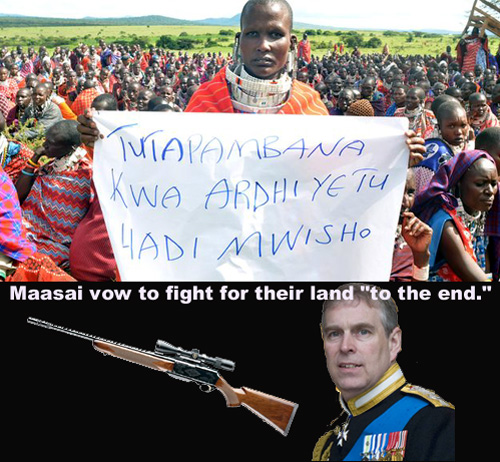Dear Grace & Other Careful Readers
Thanks. This blog is in error. The “petition site” (automatically) contacted me (their deadline for the petition is next week, June 1, 2014) and fed me the links that I took to be current. Fellow bloggers did the same and we contributed to each other’s errors. All the news below is one year old. As far as we know the eviction process is on hold as a result of a suit filed by Maasai leaders which is still alive in the Tanzanian courts.
Petition site organizers believe if they reach 34,000 signatures by June 1, 2014, they will continue the pressure needed to keep the evictions on hold, so please proceed reading and sign the petition. But my apologies to all my readers for syncing off by a year.
– Jim Heck
Desperately needed: your signature on and broadcast of a petition to stop Tanzania from giving away part of the Serengeti to Mideast princes.
Sign this petition and circulate it, now, now. We have little time.
Last year I reported that Tanzania President Kikwete announced that he was going to evict 30,000 Maasai from their homeland in Loliondo in northern Tanzania to enlarge an existing hunting preserve owned by potentates in Dubai and Jordan.
As with the stopped Serengeti Highway, the outcry was substantial, especially locally from the Maasai. Nothing more happened. Until now.
Presuming the resistance had died out, Kikwete announced last week the sale was going ahead.
Manipulating Tanzania’s incredibly corrupt laws, Kikwete has decided to designate this area as a “wildlife corridor” which allows hunting but forces the eviction of the Maasai.
Don’t be fooled by this sinister sobriquet. Kikwete and past Tanzanian presidents have close relationships with Mideast potentates, where most of these old politicians’ money is stashed.
This is a land grab if ever there were one.
And this time the impact is actually less on conservationists and tourists than on local Tanzanians.
“My people’s livelihood depends on livestock totally,” a prominent Maasai politician, Daniel Ngoitiko, told the Guardian. “We will die if we don’t have land to graze.”
And don’t think this means there’s a bunch of dirty nomads running around half naked chasing dying cattle. Loliondo has become an important agricultural hub for Tanzania. We’re talking about modern ranching.
Ngoitiko’s comments could just as easily be said word-for-word by any Texas rancher afraid of a government land grab.
I’m infuriated by Kikwete’s dictatorial stance on this, his total disregard for the Maasai community which is trying so hard and doing so well to modernize.
So just as they begin modern farming techniques, he drives a stake through their back forty. There’s everything in his actions to suggest he’d rather send the Maasai back to the Stone Age than help them develop.
Ngoitiko told the Guardian, “We will fight against it until the last person is gone,” he said. More than fifty local Maasai officials said they will resign if the move goes through, effectively leaving a huge area without any local governance.
In an incredibly condescending dismissal Tanzania’s minister for natural resources and tourism, Khamis Kagasheki, was then quoted in the Guardian article as saying: “If the civic leaders want to resign, they can go ahead. There is no government in the world that can just let an area so important to conservation to be wasted away by overgrazing.”
This is equally a blow to the Serengeti, which the area is contiguous with. It’s a wedge between Kenya’s beautifully protected Maasai Mara and the Serengeti National Park.
Inserting hunting this far into the area could disrupt normal wildlife behaviors.
Please help. Sign the petition and circulate far and wide.
